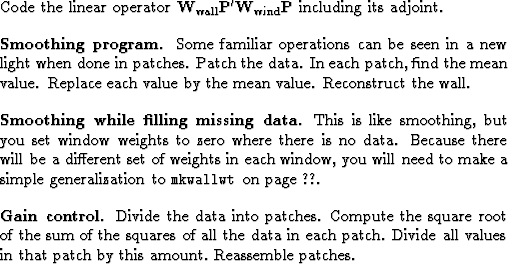




Next: STEEP-DIP DECON
Up: PATCHING TECHNOLOGY
Previous: Designing a separate filter
patch ! triangular
I have been running patching code for several years
and my first general comment is that realistic applications
often call for patches of different sizes and different shapes.
(Tutorial, non-interactive Fortran code is poorly suited to this need.)
Raw seismic data in particular seems more suited to triangular shapes.
It is worth noting that the basic concepts in this chapter
have ready extension to other shapes.
For example,
a rectangular shape could be duplicated into two identical patches;
then data in one could be zeroed above the diagonal
and in the other below;
you would have to allow, of course, for overlap the size of the filter.
Module pef ![[*]](http://sepwww.stanford.edu/latex2html/cross_ref_motif.gif) automatically ignores the zeroed portion
of the triangle,
and it is irrelevant what mis2()
automatically ignores the zeroed portion
of the triangle,
and it is irrelevant what mis2() ![[*]](http://sepwww.stanford.edu/latex2html/cross_ref_motif.gif) does with a zeroed portion of data,
if a triangular footprint of weights is designed to ignore its output.
does with a zeroed portion of data,
if a triangular footprint of weights is designed to ignore its output.






Next: STEEP-DIP DECON
Up: PATCHING TECHNOLOGY
Previous: Designing a separate filter
Stanford Exploration Project
4/27/2004
![[*]](http://sepwww.stanford.edu/latex2html/cross_ref_motif.gif) automatically ignores the zeroed portion
of the triangle,
and it is irrelevant what mis2()
automatically ignores the zeroed portion
of the triangle,
and it is irrelevant what mis2() ![[*]](http://sepwww.stanford.edu/latex2html/cross_ref_motif.gif) does with a zeroed portion of data,
if a triangular footprint of weights is designed to ignore its output.
does with a zeroed portion of data,
if a triangular footprint of weights is designed to ignore its output.
